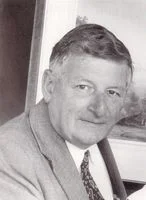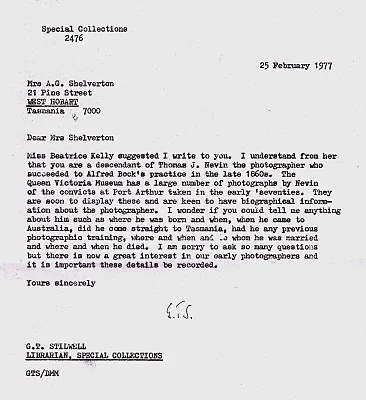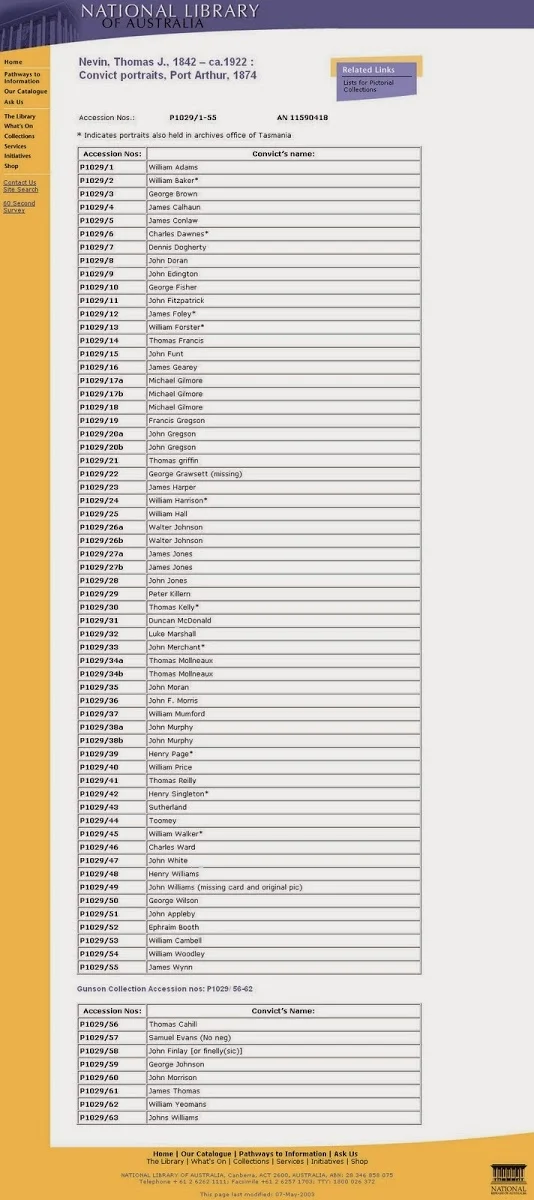Mrs SHELVERTON, grand daughter of photographer T. J. NEVIN and Elizabeth Rachel (Day) NEVIN
EXHIBITION of convict photographs 1870s taken by T. J. NEVIN, QVMAG Launceston, 1977
Preparations began in early 1977 for the Queen Victoria Museum and Art Gallery's exhibition of Thomas J. Nevin's photographs of Tasmanian prisoners taken for police and prison records in the 1870s which were (re)discovered among their John Watt Beattie holdings which were acquired by the QVMAG from Beattie's estate on his death in 1930.

Geoffrey Stilwell, Special Collections Librarian
Allport Library, State Library of Tasmania
Mercury photo 1990
The late Geoffrey Stilwell, curator of Special Collections at the State Library of Tasmania, collected biographical data on professional photographer Thomas J. Nevin (1842-1923) from a diverse range of sources, including information from Mrs Jean Shelverton, a grand-daughter of Thomas and Elizabeth Rachel (Day) Nevin. Mrs Shelverton's mother Mary Ann (Nevin) Drew who was known as Minnie to living descendants,was the second daughter and fifth child (to survive), born to photographer Thomas and Elizabeth Nevin on November 9th, 1884, in Hobart, Tasmania.

G.T. Stilwell's letter to Mrs Shelverton, 25 February 1977
Courtesy of the State Library of Tasmania
TRANSCRIPT
Dear Mrs ShelvertonMrs Shelverton provided information in answer to these questions from documents passed down from Thomas J. Nevin's estate to her mother. However, there were many more documents and photographs from the Nevin family estate still untouched in trunks, shoe boxes and garages belonging to the descendants of Thomas and Elizabeth Nevin's other five children who were not aware of the forthcoming exhibitions at the Art Gallery of NSW (1976) and the QVMAG (1977) when the State Library of Tasmania began their research. And there were many more examples of Thomas J. Nevin's "convict portraits" and other examples of his photographic work held in public institutions which were yet to be displayed online at the Tasmanian Museum and Art Gallery, the Archives Office and State Library of Tasmania, the State Library of Victoria, the National Library of Australia and the State Library of NSW, apart from private collections.
Miss Beatrice Kelly suggested I write to you. I understand from her that you are a descendant of Thomas J. Nevin the photographer who succeeded to Alfred Bock's practice in the late 1860s. The Queen Victoria Museum has a large number of photographs by Nevin of the convicts at Port Arthur taken in the early 'seventies. They are soon to display these and are keen to have biographical information about the photographer. I wonder if you could tell me anything about him such as where he was born and when, when he came to Australia, did he come straight to Tasmania, had he any previous photographic training, where and when and to whom he was married and when and where he died. I am sorry to ask so many questions but there is now a great interest in our early photographers and it is important these details be recorded.
Yours sincerely,
(G.T.S.) initials
G.T. Stilwell
LIBRARIAN, SPECIAL COLLECTIONS
GTS/DMM
A summary document was then prepared by the State Library of Tasmania, using information from shipping records held at the Archives Office of Tasmania (MB2/98) and Mrs Shelverton's information. The information was not correct in the detail of Thomas J. Nevin's date of death (1923, Southern Regional Cemetery burial records).

Biographical information on Thomas Nevin
G.T. Stilwell files, courtesy State Library of Tasmania
The handwritten insertion of Thomas J. Nevin's middle initial "J" (James) appears on this document to indicate its inclusion in his name as it appears on his government contractor stamp. The versos of a number of photographs by Nevin held at the QVMAG and the State Library of NSW Mitchell Collection are stamped with his government stamp signifying his joint copyright under a colonial Royal Warrant. The stamp included his vocational designation "T. J. Nevin Photographic Artist" and the Royal Arms insignia, a stamp he was using by February 1872.
Confusion about Thomas J. Nevin the photographer and his son by the same name - T. J. Nevin jnr (1874-1948) - has arisen in the course of the last thirty years. Thomas and Elizabeth's second child and first-born son, Thomas James Nevin jnr was born in May 1874, his birth registered by Thomas snr's father-in-law Captain James Day, while Thomas Nevin was away on business at the Port Arthur prison. The date "1874" was transcribed across the versos of several hundred of these Nevin convict photographs by archivists in the early 1900s. Known as "Sonny" to the family, Thomas J. Nevin jnr did not become a photographer. He was listed as a bootmaker on the 1905 electoral rolls, lived in California with his wife Gertrude Tennyson Bates in the 1920s, and joined the Salvation Army in Hobart sometime in the 1940s.

Prisoner SMITH, William per Rodney 3
QVMAG Collection Ref: QM: 1985 P: 131
Photographer: Thomas J. Nevin 1874
Verso stamped with Nevin’s Royal Arms government contractor stamp
In April 1977, Geoffrey Stilwell conveyed the biographical information per Mrs Shelverton to the curator of T. J. Nevin's convict photographs' exhibition at the QVMAG, John McPhee, in this letter:

Letter to John McPhee, curator, QVMAG, 4 April, 1977.
Courtesy State Library of Tasmania
TRANSCRIPT
Dear Mr McPhee,This was only the beginning of G.T. Stilwell's research. Later in 1977, two more grand daughters of Thomas and Elizabeth Nevin (daughters of their youngest son Albert) visited the exhibition at the QVMAG in Launceston. In 1978, a great grand daughter interviewed G.T. Stilwell at length, providing him with more information, including details about photographic items by the firm Nevin & Smith held in family collections. This greatly respected specialist of Tasmanian colonial collections, G.T. Stilwell, had never any doubt about his conviction of T. J. Nevin's attribution as the photographer of the Tasmanian 'convict portraits' held at the QVMAG, duplicates of which are held at the Tasmanian Museum and Art Gallery and the National Library of Australia, a conviction he later published with Professor Joan Kerr in 1992.
At last I have some biographical details about Thomas Nevin though I am afraid these are somewhat late for your exhibition. These were mainly supplied by his granddaughter Mrs Shelverton.
Thomas Nevin was born on 28 August 1842 near Belfast, Northern Ireland (Mrs S[helverton]). He was the son of Private John Nevin and Mary his wife whom he accompanied on the convict ship Fairlie which arrived at Hobart Town in July 1852. John who was one of the guards of this vessel was also accompanied by his other children Mary A. and Rebecca both under fourteen and Will[iam] J under a year old (MB2/98).
The following marriage notice appeared in the Mercury of 14 July 1871.
NEVIN-DAY – On Wednesday, 12th July, at the Wesleyan Chapel, Kangaroo Valley, by the Rev. J. Hutchison [sic], Thomas, eldest son of Mr. J. Nevin, of Kangaroo Valley, to Elizabeth Rachael, eldest daughter of Captain Day, of Hobart Town.
Kangaroo Valley is now know as Lenah Valley. From about 1876 to 1880 he lived at the Town Hall, Hobart as caretaker. Two of his four sons were born at the Town Hall residence. He had in addition two daughters one of whom was Mrs Shelverton’s mother.*
According to Mrs Shelverton he died about 1922, she is not sure of the date, and was buried at Cornelian Bay. The tombstone has now fallen over.
Yours sincerely,
[signed] G.T. STILWELL
Librarian, Special Collections
RELATED POSTS main weblog
- Nevins on sick list during voyage out on Fairlie 1852
- Mary and John Nevin, Thomas Nevin’s parents
- Professor Joan Kerr (DAA ed. 1992)
- John McPhee on Nevin in 1977 and 2007 at the QVMAG
- The Queen Victoria Museum & Art Gallery Convicts 1977




























